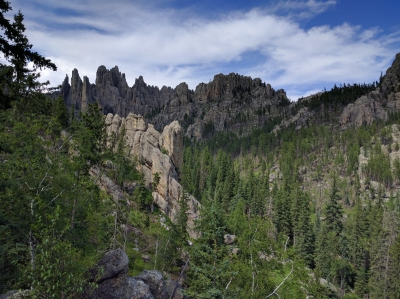The Black Hills Flood of 1972, also known as the Rapid City Flood, was the most detrimental flood in South Dakota history, and one of the deadliest floods in U.S. history. The flood took place on June 910, 1972 in the Black Hills of Western South Dakota. 15 inches (380 mm) of rain in a small area over the Black Hills caused Rapid Creek and other waterways to overflow. Severe flooding of residential and commercial properties in Rapid City occurred when Canyon Lake Dam became clogged with debris and failed in the late evening hours of June 9 resulting in 238 deaths and 3,057 injuries. Over 1,335 homes and 5,000 automobiles were destroyed. The value of property damage was estimated to be over US$160 million in 1972 dollars ($1.04 billion in 2021 dollars). Flooding also occurred in Battle, Spring, Bear Butte, and Boxelder creeks.
The Black Hills (Lakota: Ȟe Sápa; Cheyenne: Moʼȯhta-voʼhonáaeva; Hidatsa: awaxaawi shiibisha) are a small and isolated mountain range rising from the Great Plains of North America in western South Dakota and extending into Wyoming, United States. Black Elk Peak (formerly known as Harney Peak), which rises to 7,244 feet (2,208 m), is the range's highest summit. The Black Hills encompass the Black Hills National Forest. The name "Black Hills" is a translation of the Lakota Pahá Sápa. The hills are so called because of their dark appearance from a distance, as they are covered in evergreen trees.Native Americans have a long history in the Black Hills. After conquering the Cheyenne in 1776, the Lakota took the territory of the Black Hills, which became central to their culture. In 1868, the U.S. government signed the Fort Laramie Treaty of 1868, establishing the Great Sioux Reservation west of the Missouri River, and exempting the Black Hills from all white settlement forever. However, when settlers discovered gold there in 1874, as a result of George Armstrong Custer's Black Hills Expedition, miners swept into the area in a gold rush. The US government took the Black Hills and reassigned the Lakota, following the Great Sioux War of 1876, to five smaller reservations in western South Dakota, selling off 9 million acres (36,000 km2) of their former land. Unlike most of South Dakota, the Black Hills were settled by European Americans primarily from population centers to the west and south of the region, as miners flocked there from earlier gold boom locations in Colorado and Montana.As the economy of the Black Hills has shifted away from natural resources (mining and timber) since the late 20th century, the hospitality and tourism industries have grown to take its place. Locals tend to divide the Black Hills into two areas: "The Southern Hills" and "The Northern Hills." The Southern Hills is home to Mount Rushmore, Wind Cave National Park, Jewel Cave National Monument, Black Elk Peak (the highest point in the United States east of the Rockies, formerly and still more commonly known as Harney Peak), Custer State Park (the largest state park in South Dakota), the Crazy Horse Memorial, and The Mammoth Site in Hot Springs, the world's largest mammoth research facility.
Attractions in the Northern Hills include Spearfish Canyon, historic Deadwood, and the Sturgis Motorcycle Rally, held each August. The first Rally was held on August 14, 1938, and the 75th Rally in 2015 saw more than one million bikers visit the Black Hills. Devils Tower National Monument, located in the Wyoming Black Hills, is an important nearby attraction and was the United States' first national monument.

1972Jun, 9
Severe rainfall causes a dam in the Black Hills of South Dakota to burst, creating a flood that kills 238 people and causes $160 million in damage.
Choose Another Date
Events on 1972
- 21Feb
Sino-American relations
United States President Richard Nixon visits the People's Republic of China to normalize Sino-American relations. - 8May
Richard Nixon
Vietnam War: U.S. President Richard Nixon announces his order to place mines in major North Vietnamese ports in order to stem the flow of weapons and other goods to that nation. - 22May
Sri Lanka
Ceylon adopts a new constitution, becoming a Republic, changes its name to Sri Lanka, and joins the Commonwealth of Nations. - 23Jun
Central Intelligence Agency
Watergate scandal: U.S. President Richard M. Nixon and White House Chief of Staff H. R. Haldeman are taped talking about using the Central Intelligence Agency to obstruct the Federal Bureau of Investigation's investigation into the Watergate break-ins. - 1Sep
Bobby Fischer
In Reykjavík, Iceland, American Bobby Fischer beats Russian Boris Spassky to become the world chess champion.

 English
English  español
español  français
français  português
português  русский
русский  العربية
العربية  简体中文
简体中文 